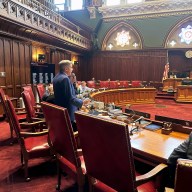Fare increases and service cuts; it’s becoming an old story for T riders.
But a report released Thursday shows a new problem looming in the distance — mega overcrowding.
The Urban Land Institute projects that within a decade, the T may see between 100,000 and 367,000 more daily riders, putting particular pressure on the Red, Orange and Green lines as well as commuter rail lines dependent on South Station.
The report’s author said those lines are either approaching capacity, at capacity, or will be beyond capacity in the future.
“The commonwealth will have to invest more money in the T, or the crunch is going to get worse,” said author Stephanie Pollack, an associate director of the Dukakis Center for Urban & Regional Policy at Northeastern University. “In order to accommodate, they need to update the system with more trains and more cars, and run them with more frequency.”
The Green Line in particular, she said, not only has issues with congestion, but has electricity and signal systems that date back to the 1920s.
Pollack predicts it could cost as much as $1 billion to accommodate the T’s growing needs.
The higher traffic will be ushered in with the development of roughly 75,000 new residential units expected to pop up around MBTA stations over the next 20 years.
The report also shows that by 2035, about 130,000 new jobs will be located in commercial space near T stations, adding to the soaring ridership.
But as long as the T can come up with the cash, Pollack said, it is good news for the local economy.
“The development community sees stations as exactly the right place to build. The whole point of putting homes and jobs near the T is for people to use transit. If we want to attract that kind of investment by developers, there has to be room on the trains,” she said.
MBTA General Manager Jonathan Davis said the report reinforces what T officials have been saying over the last year.
“A long-term financial fix is absolutely critical to stabilizing the MBTA’s budget situation and providing the resources necessary to maintain reliable service and satisfy growing demand,” Davis said.
Transit authorities have been joined by state and local leaders in the push for long-term solution to the budget troubles facing the transit system.
















